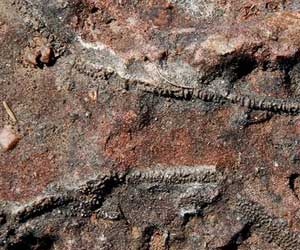 Jaisalmer, Jan 14: A team of foreign and Indian scientists have spotted the foot-prints of Dinosaurs at Thaiat village in Jaisalmer district, the sources said.
Jaisalmer, Jan 14: A team of foreign and Indian scientists have spotted the foot-prints of Dinosaurs at Thaiat village in Jaisalmer district, the sources said.
A team of 34 foreign scientists from a number of countries including France and Germany are camping here to study fossils of Dinosaurs found in sandy desert areas here recently.
Dinosaurs' evolution, extinction, and paleo-bio-genography is the center of their research related to fossils, they added.
Yesterday, the team led by Dr Jan Schlogl of Slovakia observed the footprints in one of the basal rocks of Thaiat scarp section and Professor Gregory Pienkowski of Poland identified the footprints as those of Pterosaurs or the flying dinosaur.
"The first footprint was small, only 5 cm long, but perfectly imprinted on the upper surface of a sandstone bed. Its shape and name is clear--it is called Grallator, a specific name given to the footprint, left by a small predatory dinosaur. The footprint maker was not bigger than an hen", according to the sources.
However, the second foot print was much bigger--about 30 cms long. Such tridactyl footprint (three toes) is named Eurontes giganteus and it must have been left by a much bigger creature, the sources added.
Dr P K Pandey of the Geology department at University of Rajasthan had already recorded Petrosaurs bore fragments during the previous years.
Near the Thaiat village on the Jaisalmer-Jodhpur highway there is an outcrop of Jurassic rocks. Careful geological observation by the team allowed them to interpret ancient environments in which these rocks (once soft sediments) were deposited, according to Dr Pandey.
It could be imagined that a vast coastal zone of which the Jurassic sea would be encroached some 180 million years ago, he added.
These scientists have come here on the sidelines of 9th International Congress on The Jurassic System, held between January 6- 9th, organised by Department of Geology, University of Rajasthan, Jaipur.





Comments
Add new comment